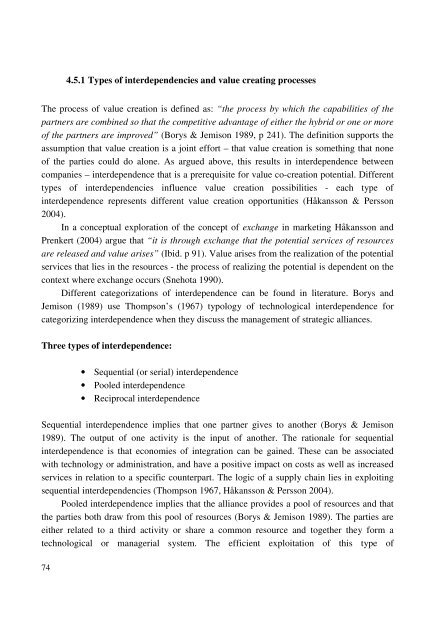Value Co-Creation in Industrial Buyer-Seller Partnerships ... - Doria
Value Co-Creation in Industrial Buyer-Seller Partnerships ... - Doria
Value Co-Creation in Industrial Buyer-Seller Partnerships ... - Doria
- No tags were found...
Create successful ePaper yourself
Turn your PDF publications into a flip-book with our unique Google optimized e-Paper software.
4.5.1 Types of <strong>in</strong>terdependencies and value creat<strong>in</strong>g processesThe process of value creation is def<strong>in</strong>ed as: “ the process by which the capabilities of thepartners are comb<strong>in</strong>ed so that the competitive advantage of either the hybrid or one or moreof the partners are improved” (Borys & Jemison 1989, p 241). The def<strong>in</strong>ition supports theassumption that value creation is a jo<strong>in</strong>t effort – that value creation is someth<strong>in</strong>g that noneof the parties could do alone. As argued above, this results <strong>in</strong> <strong>in</strong>terdependence betweencompanies – <strong>in</strong>terdependence that is a prerequisite for value co-creation potential. Differenttypes of <strong>in</strong>terdependencies <strong>in</strong>fluence value creation possibilities - each type of<strong>in</strong>terdependence represents different value creation opportunities (Håkansson & Persson2004).In a conceptual exploration of the concept of exchange <strong>in</strong> market<strong>in</strong>g Håkansson andPrenkert (2004) argue that “ it is through exchange that the potential services of resourcesare released and value arises” (Ibid. p 91). <strong>Value</strong> arises from the realization of the potentialservices that lies <strong>in</strong> the resources - the process of realiz<strong>in</strong>g the potential is dependent on thecontext where exchange occurs (Snehota 1990).Different categorizations of <strong>in</strong>terdependence can be found <strong>in</strong> literature. Borys andJemison (1989) use Thompson’ s (1967) typology of technological <strong>in</strong>terdependence forcategoriz<strong>in</strong>g <strong>in</strong>terdependence when they discuss the management of strategic alliances.Three types of <strong>in</strong>terdependence:• Sequential (or serial) <strong>in</strong>terdependence• Pooled <strong>in</strong>terdependence• Reciprocal <strong>in</strong>terdependenceSequential <strong>in</strong>terdependence implies that one partner gives to another (Borys & Jemison1989). The output of one activity is the <strong>in</strong>put of another. The rationale for sequential<strong>in</strong>terdependence is that economies of <strong>in</strong>tegration can be ga<strong>in</strong>ed. These can be associatedwith technology or adm<strong>in</strong>istration, and have a positive impact on costs as well as <strong>in</strong>creasedservices <strong>in</strong> relation to a specific counterpart. The logic of a supply cha<strong>in</strong> lies <strong>in</strong> exploit<strong>in</strong>gsequential <strong>in</strong>terdependencies (Thompson 1967, Håkansson & Persson 2004).Pooled <strong>in</strong>terdependence implies that the alliance provides a pool of resources and thatthe parties both draw from this pool of resources (Borys & Jemison 1989). The parties areeither related to a third activity or share a common resource and together they form atechnological or managerial system. The efficient exploitation of this type of74
















